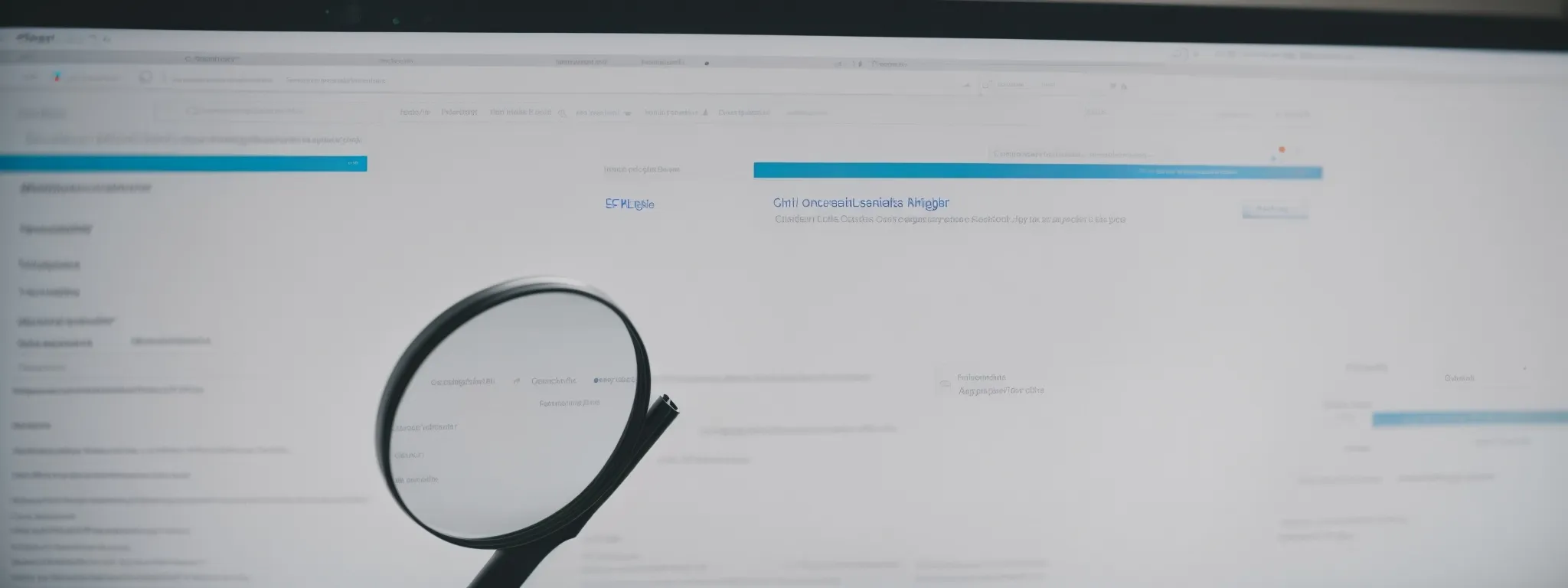Optimizing Title Tags for SEO
Mastering Title Tag Optimization for Improved SEO Results Title tags serve as the concise preview text that appears in Google search results, often being the first encounter […]
Mastering Title Tag Optimization for Improved SEO Results
Title tags serve as the concise preview text that appears in Google search results, often being the first encounter a searcher has with a brand’s web presence.
These critical HTML elements not only guide users in understanding the relevance of a page but also play a pivotal role in influencing click-through rates and a website’s SEO performance.
LinkGraph’s comprehensive approach to SEO underscores the importance of well-optimized title tags as part of a robust SEO strategy.
By mastering title tag optimization, companies can craft a pivotal touchpoint that connects with their audience and satisfies search engine algorithms simultaneously.
Keep reading to unlock the full potential of your title tags and elevate your search engine results page standing.
Key Takeaways
- Effective Title Tags Must Be Concise, Relevant, and Incorporate Strategic Keywords to Improve SERP Rankings and CTR
- Title Tag Optimization Requires a Balance of SEO Best Practices and Readability to Provide Clear and Engaging Content for the User
- Monitoring Performance Indicators Such as CTR and Search Rankings Is Essential to Assess the Effectiveness of Title Tags
- SEO Strategies Must Adapt to Algorithmic Updates and Emerging Technologies Like Voice Search and Mobile-First Indexing to Remain Effective
- Continual Learning, Community Engagement, and Iterative Optimization Are Critical for Maintaining the Efficacy of Title Tags
Understanding the Role of Title Tags in SEO

Within the intricate tapestry of search engine optimization, title tags emerge as pivotal HTML elements that guide both search engines and users in their digital quest for information.
A title tag, succinctly crafted and strategically placed, not only clarifies the theme of any given web page but also serves as a first handshake with the audience, offering an initial impression that can decisively influence click-through rates (CTR) and web traffic.
As these concise swathes of text wield significant power over search engine results page (SERP) standings, they also shape the user experience by providing clear and relevant expectations about the page content.
Thus, mastering the optimization of title tags stands as an indispensable step in ensuring one’s digital presence resonates with both the algorithms that rank pages and the individuals who engage with them.
Define What a Title Tag Is and Its Function
In the vast domain of digital marketing, a title tag functions as a succinct beacon signaling the content’s essence to search engines and users alike. It occupies a reserved space within a web page’s HTML code, typically visible in the browser tab and crucially present in the search snippet on a search engine results page (SERP).
Effective Title Tags are potent marketing tools that encapsulate the main theme of the page content while simultaneously aligning with targeted keywords. Their primary function: to accurately reflect the subject matter of the web page and entice the searcher to select and delve further into the website.
| HTML Element | Role in SEO | Impact on User |
|---|---|---|
| Title Tag | Clarifies page theme for ranking by search engines; utilizes keywords. | Provides expectational context; influences click decisions. |
Discuss How Title Tags Impact Search Engine Rankings
Title tags play a crucial role as intermediaries between web pages and search engine algorithms. They are essential indicators that help search engines comprehend the topic and relevance of a page relative to a user’s search query, which can markedly affect the page’s positioning on the SERP.
A title tag that is meticulously optimized with strategic keywords serves not only to inform but to signal authority and relevance to search engines. This optimization can elevate the perceived value of the page content in the eyes of the algorithms, ultimately enhancing the page’s search ranking and amplifying visibility to potential visitors.
Explain the Relationship Between Title Tags and User Experience
Title tags hold influence over the user experience by serving as concise signposts that navigate expectations. When skillfully optimized, they not only reflect the core subject of the page but also signal to the user that the content they are about to explore is relevant to their search, thus fostering a sense of trust and reducing bounce rates.
The correlation between the clarity of title tags and user satisfaction cannot be understated; Engaging and Descriptive Title Tags can enhance user experience by preventing confusion and frustration. This practice contributes to a more intuitive and satisfying navigation process, ultimately supporting the brand’s commitment to meeting user needs effectively.
Crafting Effective Title Tags for SEO

Enhancing the visibility and appeal of web pages in the vast digital ecosystem requires attention to the nuances of title tag optimization.
It is a strategic element of SEO that demands thoughtful consideration.
Professionals in the field of search engine optimization assert that best practices for writing title tags are more than just guidelines; they are critical steps in molding a compelling online identity.
Keywords must be placed with precision to resonate with both search engines and users, while the length of the title tag is a balancing act—long enough to be descriptive, yet succinct to maintain search engine and user engagement.
As we delve into these intricacies, the aim is to empower digital marketers and content creators with deeper insights on how to craft title tags that yield tangible improvements in search engine rankings.
Highlight Best Practices for Writing Title Tags
Forging the optimal title tag commences with adherence to the character limit, ensuring tags are compelling yet concise and within the typical 50-60 character range to avert truncation in the SERP: title tags exceeding this limit may not display in full, thereby diminishing their efficacy. Strategic Placement of Keywords at the beginning of the title tag further emphasizes relevance to both the search engine and the user, striking the delicate balance between SEO enhancement and user engagement.
| Best Practice Element | Reasoning |
|---|---|
| Character Limit Adherence | Prevents truncation in SERP, ensuring full visibility of the title tag. |
| Strategic Keyword Placement | Boosts relevance and authority in the eyes of search engines and users. |
Additionally, the incorporation of brand name towards the end of the title tag can wield substantial influence, reinforcing recognition and trust. Synergy between the title tag and the page content is paramount; an alignment that fosters coherence will secure a higher ranking and improve click-through rates, thus leveraging the potential for amplified organic traffic and heightened user experience.
Emphasize the Importance of Keyword Placement
In the art of title tag optimization, the import of keyword placement is undeniably profound. The strategic incorporation of target keywords at the beginning of a title tag reinforces the page’s relevance, directly impacting its prominence in search engine rankings and drawing the user’s eye.
Optimally positioned keywords act as a lodestar for users, guiding them through the maze of Google search results towards the most pertinent content. Through such precision, businesses bolster the probability of engaging the searcher effectively, laying the groundwork for a robust SEO strategy and an enhanced online presence.
Provide Tips on Achieving Optimal Title Tag Lengths
Securing the optimal length for title tags demands a Meticulous Approach: it is crucial to ensure that the title is long enough to communicate the essence of the web page while remaining succinct enough to avoid being cut off in the search results display. A benchmark for ideal title tag length hovers around 50-60 characters, including spaces, to maximize visibility and effectiveness within the constraints of the user’s web browser tab and the search result snippet.
- Maintain a concise title that conveys the page’s content within 50-60 characters.
- Avoid using filler words that do not contribute to the page’s relevance or search intent.
- Test the title tag in various browsers and devices to ensure consistent display across platforms.
It is essential for SEO specialists to embrace brevity while crafting title tags; an overly verbose title may detract from core messaging and diminish impact. By weaving key information into a compact and potent statement, SEO professionals can stoke user intrigue and facilitate the search engine’s comprehension of the page content, thereby influencing the site’s search engine rankings and user engagement positively.
Strategies for Optimizing Your Title Tags

In an era where online visibility is synonymous with success, optimizing title tags becomes a cornerstone of a robust search engine optimization strategy.
This critical element of SEO, when leveraged with expertise, can drastically transform a site’s digital footprint.
The upcoming discourse will unveil techniques to hone title tag relevance, effectively integrate brand names, and strike a harmonious balance between readability and SEO.
These strategies are a traversal through the nuanced scape of SEO, each contributing uniquely to elevating a website’s stature in the digital hierarchy.
Explore Techniques for Enhancing Title Tag Relevance
Optimizing title tag relevance is a critical maneuver in sharpening the focus of a web page’s subject matter for both users and search engines. Employing relevance-enhancing techniques, such as integrating semantically related keywords and phrases that complement the primary keyword, bolsters the thematic signal sent to search algorithms and molds user expectations:
| Optimization Technique | Benefit to Search Engine | Benefit to User |
|---|---|---|
| Semantic Keyword Integration | Strengthens thematic signaling for algorithms | Refines user expectation of content relevance |
Incorporating actionable language and clear call-to-action cues into title tags serves to rise above the clutter of search engine results. Doing so not only accentuates the pertinence of the content but also stirs user curiosity and compels clicks, a dual advantage that galvanizes both search engine validation and user engagement.
Discuss the Use of Brand Names in Title Tags
Incorporating a brand name into the title tag can significantly bolster brand recognition amid the sea of search engine listings. Tailoring the title tag to include a brand name at the end not only serves as a stamp of authenticity but can also enhance trust amongst users seeking familiar entities in the SERPs.
Expertly deploying the brand name within the title tag structure leverages both brand equity and relevance, contributing positively to the optimization strategy. It aids in distinguishing content in a densely competitive digital market, ultimately impacting click-through rates and fostering brand loyalty.
Outline How to Balance Readability With SEO in Title Tags
Balancing readability with SEO in title tags requires a fusion of user-centric finesse and tactical keyword placement. It is a critical challenge to ensure that the title remains accessible and engaging for the audience while incorporating SEO best practices to maintain search engine relevancy. A harmonious balance ensures that the title resonates with the user’s needs and appeals to the search algorithm’s preferences.
Creating title tags that strike this equilibrium involves weighing the natural flow of language against the strategic inclusion of target keywords: Each title must be crafted to read smoothly, inviting the audience with compelling language that also satisfies search engine criteria. Readability leads to better user engagement, while mindful keyword integration ensures that SEO objectives are not compromised:
| Aspect | Readability Focus | SEO Focus |
|---|---|---|
| Language | Engaging, clear, and audience-friendly | Incorporates target keywords effectively |
| Objective | Enhances user comprehension and interest | Aligns with search engine ranking requirements |
Title Tag Pitfalls to Avoid for Better SEO

In the realm of search engine optimization, title tags hold the power to make or break a website’s search engine placement, yet they are frequently mishandled.
Identifying and steering clear of typical errors in title tag optimization is an essential practice for SEO professionals determined to elevate online performance.
Prosaic mistakes such as duplicating title tags across multiple pages or the excessive stuffing of keywords can thwart search engine credibility and diminish the quality of user experience.
It is imperative to recognize these practices not only as detrimental to a site’s SEO stature but also as missed opportunities for crafting unique and compelling entry points into the website’s content.
Identify Common Title Tag Optimization Errors
One prevalent error in title tag optimization is neglecting to customize title tags for each individual web page. This oversight leads to generic tags that fail to succinctly communicate the unique content of the page, adversely impacting the relevance in the eyes of search engines and hindering a page’s potential to stand out in the SERPs.
Another frequent misstep in title tag optimization is the over-optimization trap, where the eagerness to rank higher results in keyword stuffing. Such practices deteriorate the readability of title tags and prompt search engines to label the page as spam, undermining the credibility of the website and diminishing its ranking potential.
Explain the Negative SEO Impact of Duplicate Title Tags
Duplicate title tags constitute a significant oversight in search engine optimization practices, inadvertently signaling to search engines a lack of specificity and differentiation among web pages. This redundancy confuses search algorithms which may struggle to identify and appropriately index the unique content of each page, potentially diluting the site’s overall SEO efficacy and diminishing its visibility.
Uniformity in title tags across various pages tarnishes the website’s ability to target a diverse array of search queries, thereby limiting the reach of the content and impeding the user’s ability to locate precise information. Such a misstep can result in lower click-through rates and a suboptimal user experience, which ultimately hampers the site’s ranking and performance in search engine results.
Warn Against Overusing Keywords in Title Tags
An excessive concentration of keywords within title tags, a practice known as keyword stuffing, is a counterproductive approach that hampers both readability and search engine rankings. This form of overoptimization can cause search engines to deem the content as manipulative, leading to negative SEO consequences and potentially triggering penalties that suppress a website’s visibility.
Search engine algorithms are engineered to reward the natural use of language and valuable user-focused content, rather than pages that artificially inflate their relevance. Thus, SEO specialists must ensure title tags are thoughtfully composed to include keywords in a manner that prioritizes user intent and engagement, steering clear of practices that might compromise the integrity of their SEO efforts.
Analyzing and Improving Existing Title Tags

In the pursuit of search engine superiority, scrutinizing and refining title tags is an exercise of monumental importance for website owners and SEO professionals.
Thorough analysis of existing title tags unveils insights into optimization potential, directing attention to areas ripe for improvement.
Providing a roadmap for conducting meticulous title tag audits, this section details analytical methodologies and suggests State-of-the-Art Tools to refine these critical HTML elements.
Armed with actionable steps, even the most ineffective title tags can be revitalized to drive better SEO results, thereby sharpening the website’s competitive edge in the digital landscape.
Guide Readers on Conducting a Title Tag Audit
Embarking on a title tag audit necessitates a methodical approach, scrutinizing each page to assess alignment with overarching SEO objectives and user intent: Involved parties must inspect whether title tags encapsulate core topics, integrate targeted keywords efficiently, and adhere to length constraints while remaining compelling to the user.
| Page Element | Consideration | SEO Best Practice |
|---|---|---|
| Title Tag Content | Relevance to page topic and user search queries | Incorporation of targeted keywords; clear, concise language |
| Title Tag Length | Visibility in SERPs without truncation | Maintaining 50-60 characters with spaces |
A meticulous review should also encompass comparisons against competitors’ title tags and the prevailing efficacy in capturing user attention: Such an approach enables practitioners to distinguish areas of enhancement and recalibrate tags for optimal search engine ranking and user click-through rates.
Offer Actionable Steps for Revising Ineffective Title Tags
Revising ineffective title tags begins with the re-evaluation of current keywords, ensuring they align with the latest search trends and the genuine queries of the audience. SEO practitioners are advised to replace outdated or underperforming keywords with more accurate and trending alternatives, thereby raising the tags’ relevance and search engine prominence.
SEO professionals should concentrate on enhancing the specificity and appeal of title tags, tailoring them to articulate the unique value proposition of the web page. This involves crafting a title that not only includes target keywords but also encapsulates the essence of the content in a way that is both engaging and insightful, setting the stage for improved user click-through and search engine attraction.
Suggest Tools for Title Tag Analysis and Optimization
Title tag analysis and optimization are bolstered by tools that provide comprehensive insights into efficacy and compliance with SEO best practices. One such essential tool is LinkGraph’s SearchAtlas SEO software, which offers robust diagnostic features like free SEO audits and free backlink analyses to evaluate and refine title tags for optimal performance.
Additionally, SearchAtlas streamlines the optimization process, enabling SEO professionals to judiciously adjust title tags and test their potential impact in real-time. This advanced software facilitates the fine-tuning of tags, ensuring they are primed to captivate the user while satisfying the intricate algorithms that govern search engine rankings.
Measuring the Success of Your Title Tag Optimization

Optimizing title tags is an exercise in precision, whereby Thoughtful Analysis and adjustment can culminate in substantial gains in search visibility and user engagement.
Yet the true efficacy of these endeavours hinges on the ability to measure outcomes against Reliable Metrics.
It is through assessing title tag performance with key indicators, leveraging the insights garnered from A/B testing, and tracking fluctuations in search rankings that SEO professionals can gauge the Impact of Their Optimizations.
This empirical approach facilitates the refinement of strategies, ensuring title tags are not only well-crafted but also effective in achieving SEO goals.
Define Key Metrics for Assessing Title Tag Performance
Determining the impact of title tag optimization necessitates monitoring specific performance indicators. Among these metrics, click-through rate (CTR) stands as a critical gauge, providing insight into the percentage of users who encounter a title in search results and are compelled to click on it.
Another important measure of title tag effectiveness is the page’s ranking for targeted search terms, indicative of the title’s resonance with search engine algorithms. A title tag that successfully captures the essence of the content and incorporates appropriate keywords can ascend in search engine rankings, increasing the site’s visibility:
- Analysis of click-through rates (CTR) for understanding user engagement.
- Tracking changes in search engine rankings for targeted keywords.
- Page views and time spent on page as indicators of content relevance and user experience.
Discuss the Role of a/B Testing in Title Tag Optimization
A/B testing plays an integral role in the meticulous process of title tag optimization, enabling a Data-Driven Approach to refine the appeal and effectiveness of these critical HTML elements. By creating and comparing different versions of a title tag, SEO professionals can discern which variations resonate most effectively with their audience, leading to higher click-through rates and improved search rankings.
This empirical method leverages real-world user data to inform strategic adjustments, facilitating a more scientifically grounded approach to SEO. As marketers iterate through different title tags, A/B testing uncovers granular insights about user preferences and behaviors, contributing to the continuous enhancement of a website’s digital presence and user engagement.
| A/B Testing Stage | Purpose | Expected Outcome |
|---|---|---|
| Creating Variants | To test the efficacy of different title tag compositions | Identification of the title tag that garners higher CTR |
| Iterative Testing | To refine the optimization based on user data | Continuous improvement in title tag performance and SEO results |
Introduce Methods to Track Improvements in Search Rankings
Tracking the trajectory of search rankings following title tag optimization offers a tangible metric for assessing the effectiveness of SEO efforts. Observing rankings over time for targeted keywords highlights the shifts that result from optimization strategies, underscoring the importance of precision in Title Tag Crafting.
| Rank Tracking Factor | Method | Outcome |
|---|---|---|
| Targeted Keywords | Monitor ranking position changes | Understanding the direct impact of title tag adjustments |
| Temporal Analysis | Assess ranking fluctuations over specific periods | Identify long-term trends in SEO performance |
Deploying reliable SEO tools like LinkGraph’s SearchAtlas Software streamlines the monitoring process, offering incisive SEO reporting insights and alerts when position changes occur. This granularity facilitates swift responses to volatile search landscapes, enabling SEO practitioners to adapt and refine optimizations to sustain upward momentum in search rankings.
Future-Proofing Your Title Tags Against Algorithm Changes

In the ever-evolving landscape of search engine optimization, safeguarding the efficacy of title tags against the relentless tide of algorithmic updates is essential for maintaining a resilient and robust online presence.
Forward-thinking SEO strategies anticipate shifts in digital paradigms, embracing adaptive measures to ensure that title tags continue to serve their pivotal role in connecting content with its intended audience.
This involves a continuous commitment to aligning with the latest search engine guidelines and fostering SEO best practices that empower title tags to remain a potent ally in the quest for superior search rankings, irrespective of the changes on the digital horizon.
Provide Insights Into Adapting Title Tags for Future SEO Trends
In preparing for future SEO trends, it is essential for marketers to remain agile—ready to pivot as search engines refine their algorithms. A proactive approach to title tag optimization might involve embracing semantic richness, integrating topical relevance and User-Centric Verbiage, ensuring tags resonate with emerging search patterns and algorithmic preferences.
Marketers must also keep apace with the technological advancements shaping search engine behaviors, such as the rise in voice search and mobile-first indexing. Optimizing title tags for conversational queries and seamless mobile display will become increasingly imperative as these trends continue to dictate user search habits and, consequently, search engine ranking factors.
| SEO Trend | Title Tag Adaptation | Anticipated Benefit |
|---|---|---|
| Rise in Voice Search | Incorporate natural, conversational language | Alignment with voice query patterns enhances visibility |
| Mobile-first Indexing | Ensure title tags are concise and mobile-friendly | Improved user experience on mobile devices increases CTR |
Emphasize the Importance of Staying Updated With Search Engine Guidelines
Staying abreast of the latest search engine guidelines is an essential aspect of maintaining the efficacy of title tags within the realm of SEO. Search engines periodically update their algorithms to improve user experience and provide more accurate search results, and these updates can significantly impact the effectiveness of a website’s SEO strategies, including those pertaining to title tags.
SEO professionals and website owners must vigilantly monitor search engine announcements and adapt their title tag strategies accordingly. This proactive approach ensures that title tags continue to comply with current standards and best practices, thus safeguarding a website’s search rankings and online visibility amidst dynamic algorithmic shifts.
Suggest Best Practices for Maintaining Optimized Title Tags Over Time
To ensure title tags retain their SEO potency over time, it is imperative for practitioners to engage in continual learning and iterative optimization processes. Staying informed of industry trends, frequented by proficient forums, and keeping an eye on the analytical data emanating from one’s own digital properties forms a trinity of imperatives:
- Actively participating in relevant SEO communities to stay informed of the latest trends and algorithmic changes.
- Committing to regular reviews of website analytics to discern shifts in user interaction with title tags.
- Implementing iterative updates to title tags, informed by ongoing learning and performance metrics.
Moreover, integrating user feedback into the title tag refinement process strengthens their relevance and attracts higher engagement. Soliciting direct input through social media sites, user surveys, and behavior patterns observed through analytics tools can reveal invaluable insights, guiding the crafting of title tags that resonate profoundly with the target demographic.
Conclusion
Mastering title tag optimization is essential for boosting SEO results and enhancing online visibility.
A well-crafted title tag serves as a critical signal to both search engines and users, outlining the content’s theme and drawing in clicks.
Maintaining the optimal length, positioning keywords strategically, and incorporating the brand name effectively are best practices that contribute to a title tag’s success.
Common mistakes like duplicate tags and keyword stuffing should be avoided as they harm search rankings and user experience.
Regular audits and revisions of title tags, utilizing tools such as LinkGraph’s SearchAtlas SEO software, are key to staying competitive.
Measuring the optimization’s success involves tracking metrics like click-through rates and changes in search rankings, while A/B testing allows for data-driven refinement of title tags.
As search engine algorithms evolve, staying updated with guidelines and adapting to SEO trends will ensure title tags maintain their effectiveness.
Ultimately, an ongoing commitment to optimization and responsiveness to user feedback are paramount in securing improved SEO results through the strategic use of title tags.














































































